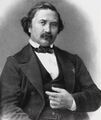Template:Selected anniversaries/March 11: Difference between revisions
No edit summary |
No edit summary |
||
| Line 2: | Line 2: | ||
||1437: In what is now modern-day Seoul, a new star appeared in the sky, seemingly out of nowhere. The newcomer shone for 14 days before fading into the darkness. Korean astronomers noted the mysterious star and its brief stint in the sky in their records. | ||1437: In what is now modern-day Seoul, a new star appeared in the sky, seemingly out of nowhere. The newcomer shone for 14 days before fading into the darkness. Korean astronomers noted the mysterious star and its brief stint in the sky in their records. | ||
||1636: Christoph Grienberger dies ... Jesuit astronomer, after whom the crater Gruemberger on the Moon is named. | ||1636: Christoph Grienberger dies ... Jesuit astronomer, after whom the crater Gruemberger on the Moon is named. Pic. | ||
File:Urbain Le Verrier.jpg|link=Urbain Le Verrier (nonfiction)|1811: Mathematician and astronomer [[Urbain Le Verrier (nonfiction)|Urbain Le Verrier]] born. He will predict the existence and position of Neptune using only mathematics, an event which will be widely regarded as one of the most remarkable moments of 19th century science. | File:Urbain Le Verrier.jpg|link=Urbain Le Verrier (nonfiction)|1811: Mathematician and astronomer [[Urbain Le Verrier (nonfiction)|Urbain Le Verrier]] born. He will predict the existence and position of Neptune using only mathematics, an event which will be widely regarded as one of the most remarkable moments of 19th century science. | ||
||1812: Philip James de Loutherbourg dies ... painter who became known for his large naval works, his elaborate set designs for London theatres, and his invention of a mechanical theatre called the "Eidophusikon". | ||1812: Philip James de Loutherbourg dies ... painter who became known for his large naval works, his elaborate set designs for London theatres, and his invention of a mechanical theatre called the "Eidophusikon". Pic. | ||
||1818: Henri Étienne Sainte-Claire Deville born. | ||1818: Henri Étienne Sainte-Claire Deville born. | ||
Revision as of 19:36, 27 February 2019
1811: Mathematician and astronomer Urbain Le Verrier born. He will predict the existence and position of Neptune using only mathematics, an event which will be widely regarded as one of the most remarkable moments of 19th century science.
1821: Poet, painter, and printmaker William Blake publishes his award-winning illustrations of demons and angels. A generation later, mathematicians will discover hidden clues to imminent crimes against mathematical constants.
1822: Mathematician, economist, and academic Joseph Louis François Bertrand born. He will work in the fields of number theory, differential geometry, probability theory, economics and thermodynamics.
1823: Publication of Niles Cartouchian and Anton Rhodomunde Confront Gnotilus causes widespread debate about the role of private citizens in fighting crimes against mathematical constants.
1880: American eugenicist and sociologist Harry H. Laughlin born. He will be the Superintendent of the Eugenics Record Office from its inception in 1910 to its closing in 1939, and among the most active individuals in influencing American eugenics policy, especially compulsory sterilization legislation.
1971: Inventor Philo Farnsworth dies. He made many crucial contributions to the early development of all-electronic television.
1996: Engineer and inventor Charles William Oatley dies. He developed of one of the first commercial scanning electron microscopes.
- Rudolph Hell.gif
2002: Inventor and engineer Rudolf Hell dies. He invented the Hellschreiber teleprinter system.
2018: Signed first edition of Red Spiral stolen The State Hermitage Museum in Saint Petersburg, Russia, during a stealthy overnight heist allegedly masterminded by the Forbidden Ratio gang.







